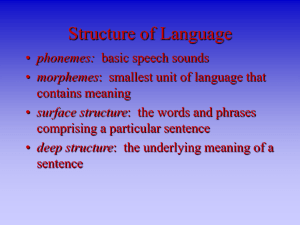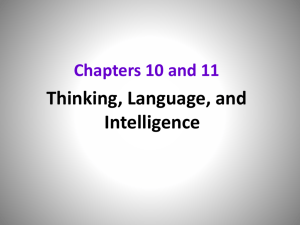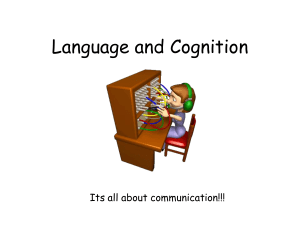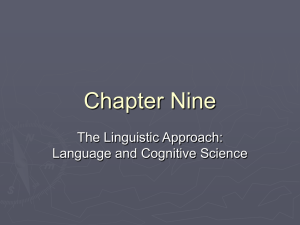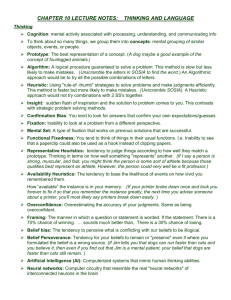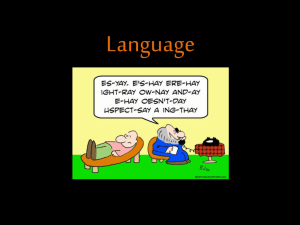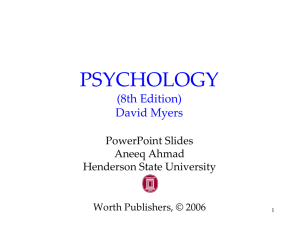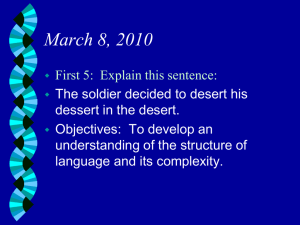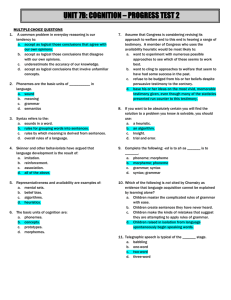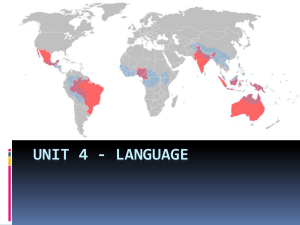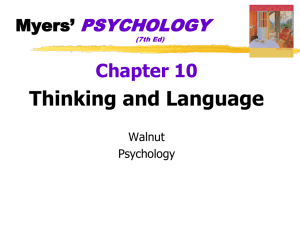Thinking and Language
advertisement
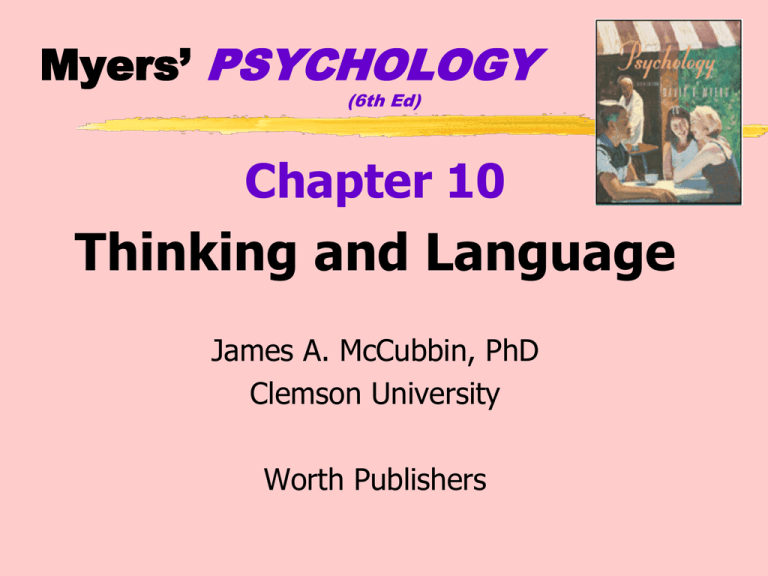
Myers’ PSYCHOLOGY (6th Ed) Chapter 10 Thinking and Language James A. McCubbin, PhD Clemson University Worth Publishers Thinking Cognition mental activity associated with processing, understanding, and communicating information Cognitive Psychology the study of these mental activities concept formation problem solving decision making judgement formation study of both logical and illogical thinking Thinking Concept mental grouping of similar objects, events, or people address • country, city, street, house • zip codes Prototype the best example of a category matching new items to the prototype provides a quick and easy method for including items in a category (as when comparing feathered creatures to a prototypical bird, such as a robin.) Thinking Algorithm methodical, logical rule or procedure that guarantees solving a particular problem contrasts with the usually speedier – but also more error-prone use of heuristics Thinking Heuristic rule-of-thumb strategy that often allows us to make judgements and solve problems efficiently usually speedier than algorithms more error-prone than algorithms sometimes we’re unaware of using heuristics Thinking Unscramble SPLOYOCHYG Algorithm all 907,208 combinations Heuristic throw out all YY combinations other heuristics? Thinking Insight sudden and often novel realization of the solution to a problem contrasts with strategy-based solutions Confirmation Bias tendency to search for information that confirms one’s preconceptions Fixation inability to see a problem from a new perspective impediment to problem solving The Matchstick Problem How would you arrange six matches to form four equilateral triangles? The Candle-Mounting Problem Using these materials, how would you mount the candle on a bulletin board? Thinking Mental Set tendency to approach a problem in a particular way especially a way that has been successful in the past but may or may not be helpful in solving a new problem Thinking Functional Fixedness tendency to think of things only in terms of their usual functions impediment to problem solving The Matchstick Problem Solution to the matchstick problem The Three-Jugs Problem Solution: a) All seven problems can be solved by the equation shown in (a): B-A-2C= desired volume. b) But simpler solutions exist for problems 6 and 7, such as A-C for problem 6. The Candle-Mounting Problem Solving this problem requires recognizing that a box need not always serve as a container Types of Heuristics Availability- relying on info that is more easily recalled and overlook less prominent info Lottery winnings Representativeness- assuming that if an item similar to members of a category, it probably is a member too Coin flipping Anchoring- making decisions based on ideas that are important to us People who sleep in are lazy Thinking Overconfidence tendency to be more confident than correct tendency to overestimate the accuracy of one’s beliefs and judgements Thinking Framing the way an issue is posed how an issue is framed can significantly affect decisions and judgements Example: What is the best way to market ground beef- As 25% fat or 75% lean? Brain Teasers 1) If there are 7 months that have 31 days in them and 11 months that have 30 days in them, how many months have 28 days in them? 2) What is boiled then cooled, sweetened then soured? 3) A woman gives a beggar 50 cents; the woman is the beggar’s sister, but the beggar is not the woman’s brother. Why? 4) What is brought to the table and cut, but never eaten? 5) What is neither inside a house nor outside a house, but no house would be complete without it? 6) Two men play five games of checkers. Each man wins the same number of games. There are no ties. Explain this. 7) What is pronounced like one letter, written with three letters, and belongs to all animals? 8) What is the beginning of eternity, the end of time and space, the beginning of every end, and the end of every race? 9) What is very light but can’t be lifted? 10) What overpowers you without hurting you? Brain Teasers 11) What question can you never answer “yes” to? 12) I have two U.S. coins totaling 55 cents. One is not a nickel. What are the coins? 13) If you only have one match and you walked into a room where there was an oil burner, a kerosene lamp, and a wood burning stove, which one would you light first? 14) Which two letters of the alphabet are nothing? 15) How far can a dog run into the woods? 16) With what vegetable to you throw away the outside, cook the inside, eat the outside, and throw away the inside? 17) A clerk in the butcher shoe is 5’10” tall. What does he weigh? 18) A man and a dog going down the street. The man rode; yet walked. What was the dog’s name? 19) If the ruler of Russia was the Czar and his wife the Czarina, what were his children called? 20) How can you make seven even? Belief Bias Democrats support free speech. Dictators are not democrats. Dictators do not support free speech. Robins have feathers. Chickens are not robins. Therefore, chickens do not have feathers. Thinking Belief Bias the tendency for one’s preexisting beliefs to distort logical reasoning sometimes by making invalid conclusions seem valid, or valid conclusions seem invalid Belief Perseverance clinging to one’s initial conceptions after the basis on which they were formed has been discredited Language Language our spoken, written, or gestured works and the way we combine them to communicate meaning Phoneme in a spoken language, the smallest distinctive sound unit What Are Phonemes? PHONEME - shortest segment of speech, which, if changed, would change the meaning of a spoken word. /bit/ /bait/ /beet/ Only 60 phonemes necessary to account for all worlds’ languages! English requires 48 phonemes. Hawaiian requires only 11! What Are Morphemes? Morpheme - the shortest unit of spoken or written language that carries meaning Some morphemes are phonemes (e.g., “I” and “a”) Most are combos of 2 or more phonemes Some morphemes are words (e.g., “bat”) Language Morpheme in a language, the smallest unit that carries meaning may be a word or a part of a word (such as a prefix) Grammar a system of rules in a language that enables us to communicate with and understand others Language Semantics the set of rules by which we derive meaning from morphemes, words, and sentences in a given language also, the study of meaning Syntax the rules for combining words into grammatically sensible sentences in a given language Language Development How Many Words Do You Know? Average High School Grad Knows ~ 80,000 words Schools teach approx 200 words per year BUT You learned approx 5,000 words per year! How Did You Learn All Those Other Words?!? Language We are all born to recognize speech sounds from all the world’s languages Percentage able 100 to discriminate 90 Hindi t’s 80 70 60 50 40 30 20 10 0 Hindispeaking adults 6-8 months 8-10 months 10-12 months Infants from English-speaking homes Englishspeaking adults Language Babbling Stage beginning at 3 to 4 months the stage of speech development in which the infant spontaneously utters various sounds at first unrelated to the household language One-Word Stage from about age 1 to 2 the stage in speech development during which a child speaks mostly in single words Language Two-Word Stage beginning about age 2 the stage in speech development during which a child speaks mostly two-word statements Telegraphic Speech early speech stage in which the child speaks like a telegram – “go car” – using mostly nouns and verbs and omitting “auxiliary” words Language Summary of Language Development Month (approximate) Stage 4 Babbles many speech sounds. 10 Babbling reveals households language. 12 One-word stage. 24 Two-world, telegraphic speech. 24+ Language develops rapidly into Complete sentences. Explaining Language Development Skinner- Operant Conditioning Association, imitation, and reinforcement Chomsky- Inborn Universal Grammar Acquire grammar and language without being taught Over-generalizing Cognitive Neuroscientists- Statistical Learning Gradual changes in neural networks based on experience First few years are critical A B C D E F Suddenly Several Naked Giraffes Ran Into the room Slowly Six Hairy Martians Jumped Out of the box Without warning Those Bloody Students Slipped Between the houses Amazingly Some Blueblooded Dalmatians Fled Reluctantly The Laughing Duchesses Skipped Down the road Carefully A few Dark Boys Crawled Over the hill Fortunately A great many Bald Lawyers Darted Through the tunnel Cunningly Twentytwo Unscrup- Octoulous genarians Danced Across the bridge In due course Innumer Dirty able Limped Up the street Feminists From behind the trees Doublespeak Revenue enhancement Inoperative statements Social expression products Poorly buffered precipitation Media courier Oral hygiene appliance Negative patient care outcome Vertical transportation corps Period of accelerated negative growth Radiation enhancement device Automotive internist Pre-emptive counterattacks Pupil station Underground condominium Digital fever computer Language Genes design the mechanisms for a language, and experience fills them as it modifies the brain Language Environment spoken language heard provides input to Genes Brain design Mechanisms for understanding and producing language Behavior Mastery of native language Language Percentage correct on grammar test New language learning gets harder with age 100 90 80 70 60 50 Native 3-7 8-10 11-15 17-39 Age at school Language Linguistic Relativity Whorfs hypothesis that language determines the way we think Language Direction of nectar source The straight-line part of the dance points in the direction of a nectar source, relative to the sun Are We Alone? Can apes be taught “language”? Washoe learned 132 signs by age 4 and 240 signs by age 27 Evidence of creative sentence construction Vocabularies and sentences are simple (2 yr old child) But are apes really using “language”? Animal Use of Language Beatrice Gardner- raised a baby chimp named Washoe and taught ASL Knew 87 signs by 3 ½ Knew 160 signs by 5 Can also use keyboards Cannot apply grammatical rules or arrange symbols to create new meanings (grammar) So…Can Apes Possess Language? It depends... Verbal or signed expression of complex grammar? No. Communication through a meaningful sequence of symbols? Yes.
